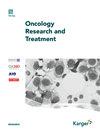Clinicopathologic Features And Efficacy Of Induction Chemotherapy In Nasopharyngeal Carcinoma: Real-World Experience.
IF 2
4区 医学
Q3 ONCOLOGY
引用次数: 0
Abstract
INTRODUCTION Nasopharyngeal carcinoma (NPC) accounts for 0.01% of all carcinomas, and 70% of patients have locally advanced disease with a poor prognosis. The mainstay therapy is chemoradiotherapy (CRT), and concurrent administration of platinum-based agents and irradiation provides high local control rates. However, induction (neoadjuvant) chemotherapy (ICT) prior to chemoradiotherapy is recommended for large tumors with a high tumor burden at category 1 level. For induction chemotherapy, platinum-based doublet or triplet combination regimens are recommended. Selected patients with high tumor burden at the time of diagnosis who did not receive induction chemotherapy before chemoradiotherapy were given adjuvant (consolidation) therapy after chemoradiotherapy. This multi-center study aims to share our experience in treatment of NPC and evaluate the factors associated with survival. METHODS The study included patients diagnosed with NPC who were followed and treated between 2008 and 2022. 142 patients from 6 centers were evaluated. The factors associated with disease-free survival (DFS) overall survival (OS) were evaluated. RESULTS The median age of our patients was 51 years (IQR: 16-81 years), and the male:female ratio was 2.5:1. A majority of patients (71%) had stage 3-4 disease. They had locally advanced disease, and 48 patients (34%) received induction chemotherapy. Twenty patients (14%) received adjuvant therapy. The median follow-up was 41 months (range, 2.7 to 175.1 months). The median DFS in NPC was 92.6 months (range, 71.9 to 113.3 months), with the 40th month DFS of 70.9%. The median OS was 113 months (range, 91 to 135 months), with the 40th month OS of 84.7%. Median DFS was 95.3 months (range, 64.2 to 126.4 months) in patients who received induction chemotherapy before CRT, which was longer than in the CRT-only group (p=0.6). DFS at the 40th month was 75.1% in patients treated with induction chemotherapy compared to 65.1% in the CRT-only group. Median OS was 117 months (range, 92 to 142 months) in patients receiving induction chemotherapy, which was longer than in the CRT-only group (p=0.4). OS at the 40th month was 86.7% in patients receiving ICT, but 83.6% in the CRT-only group. CONCLUSIONS Both objective response rate (ORR) and survival were longer in patients who radiologically responded to chemoradiotherapy following induction chemotherapy. Non-response to induction chemotherapy is a negative predictive indicator. The role of induction chemotherapy in locally advanced NPC is increasing.鼻咽癌的临床病理特征和诱导化疗的疗效:真实世界的经验。
简介鼻咽癌(NPC)占所有癌症的0.01%,70%的患者为局部晚期,预后较差。主要的治疗方法是化学放疗(CRT),同时使用铂类药物和照射可提供较高的局部控制率。不过,对于肿瘤体积大、肿瘤负荷高的一类肿瘤,建议在化放疗前进行诱导(新辅助)化疗(ICT)。对于诱导化疗,推荐使用以铂类为基础的双联或三联方案。部分确诊时肿瘤负荷较高的患者在化放疗前未接受诱导化疗,则在化放疗后接受辅助(巩固)治疗。这项多中心研究旨在分享我们治疗鼻咽癌的经验,并评估与生存相关的因素。对来自6个中心的142名患者进行了评估。结果患者的中位年龄为51岁(IQR:16-81岁),男女比例为2.5:1。大多数患者(71%)的疾病处于 3-4 期。48名患者(34%)接受了诱导化疗。20名患者(14%)接受了辅助治疗。中位随访时间为41个月(2.7至175.1个月)。鼻咽癌的中位 DFS 为 92.6 个月(范围为 71.9 至 113.3 个月),其中第 40 个月的 DFS 为 70.9%。中位 OS 为 113 个月(范围为 91 至 135 个月),第 40 个月的 OS 为 84.7%。在CRT前接受诱导化疗的患者的中位DFS为95.3个月(范围为64.2至126.4个月),比单纯CRT组更长(P=0.6)。接受诱导化疗的患者在第40个月时的DFS为75.1%,而单纯CRT组为65.1%。接受诱导化疗患者的中位OS为117个月(92至142个月),长于纯CRT组(P=0.4)。接受ICT治疗的患者第40个月的OS为86.7%,而仅接受CRT治疗组的OS为83.6%。对诱导化疗无反应是一个阴性预测指标。诱导化疗在局部晚期鼻咽癌中的作用越来越大。
本文章由计算机程序翻译,如有差异,请以英文原文为准。
求助全文
约1分钟内获得全文
求助全文
来源期刊

Oncology Research and Treatment
ONCOLOGY-
CiteScore
3.20
自引率
0.00%
发文量
84
期刊介绍:
With the first issue in 2014, the journal ''Onkologie'' has changed its title to ''Oncology Research and Treatment''. By this change, publisher and editor set the scene for the further development of this interdisciplinary journal. The English title makes it clear that the articles are published in English – a logical step for the journal, which is listed in all relevant international databases. For excellent manuscripts, a ''Fast Track'' was introduced: The review is carried out within 2 weeks; after acceptance the papers are published online within 14 days and immediately released as ''Editor’s Choice'' to provide the authors with maximum visibility of their results. Interesting case reports are published in the section ''Novel Insights from Clinical Practice'' which clearly highlights the scientific advances which the report presents.
 求助内容:
求助内容: 应助结果提醒方式:
应助结果提醒方式:


